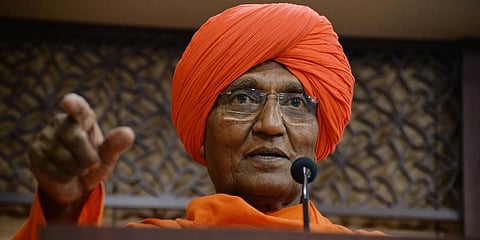

Swami Agnivesh was perhaps best known for his campaign against the horrific practice of bonded labour. But there were many other causes that he was associated with in his more than four decades of public service: Alongside his fellow citizens, he unflaggingly battled injustice, communalism and authoritarianism. He was a constant and persistent presence, fighting the battle of the day to preserve the foundations of Indian democracy and uphold the values of the Constitution.
If he was jailed for 14 months for his opposition to the Emergency imposed by Indira Gandhi in 1975, he joined forces with former chairperson of the National Minority Commission Wajahat Habibullah and Bhim Army chief Chandrashekhar Azad more than four decades later to file a petition against the Citizenship Amendment Act (CAA), pointing out that the amended Act created a classification based on religion, thereby violating the basic structure of the Constitution.
He lent his voice to many major people’s movements over the last few decades, whether that was the Narmada Bachao Andolan, against economic globalisation or Anna Hazare’s anti-corruption campaign. He was at the forefront of demanding the abolition of manual scavenging, an end to the practice of sati and female foeticide, and the entry of Dalits into temples. In 2010, during the Congress-led UPA government’s second term, he was appointed as a mediator for a dialogue with the Maoists.
He led marches with Asghar Ali Engineer to defuse communal violence and helped launch a multi-religious forum called Religions for Social Justice, leading a group of 55 religious leaders to the place where Australian Christian missionary Graham Staines and his two sons were burned to death in their sleep by members of the Bajrang Dal.
For the BJP and its RSS affiliates, that he carried out all his activities dressed in a saffron turban—that resembled the one worn by Swami Vivekananda—and robes as a member of the Arya Samaj (in 2004, he became President of the World Council of the Arya Samaj), was an affront. It was not surprising, therefore, that he was assaulted by BJP activists in New Delhi outside their party headquarters in 2018 when he was on his way to pay his respects to the mortal remains of former prime minister Atal Bihari Vajpayee.
The assailants grabbed his turban and shawl and beat him up. For the soft-spoken, then 78-year-old Swami Agnivesh, it was a great shock. In an article in another media platform, he later wrote: “I have been an eyesore to the RSS for long because of my life-long commitment to social justice. The ideal of justice is an irritant to the RSS.” Swami Agnivesh’s great contribution will always remain what he was able to achieve through the Bandhua Mukti Morcha (BMM), the organisation he set up in 1981 that since then has freed more than 1,72,000 workers. Not to mention the trade unions he set up—including those for brick kiln, stone quarry and construction workers.
For his pioneering work, he was thrice elected as Chairperson of the UN Trust Fund on Contemporary Forms of Slavery. But despite his life-long battle against the BJP/RSS combine—he famously said that it was citizenship rather than Hindutva that bound the people of India together—he failed to deploy the Arya Samaj, of which he was a leading light, to counter the Hindutva narrative. He was uniquely positioned to do so, but perhaps, he spent his time fighting too many battles.
Born Vepa Shyam Rao on 21 September 1939 in Srikakulam, Andhra Pradesh, Swami Agnivesh’s maternal grandfather—in whose home he grew up—was the Diwan of a princely state called Shakti, now in Chhattisgarh. With degrees in law and business management, he became a lecturer at St Xavier’s, Kolkata and, for some years, practised law under Sabyasachi Mukherjee, who later became the Chief Justice of India. Though he belonged to an orthodox Hindu Brahmin family, he became a full-time worker of the Arya Samaj, a Hindu reformist movement, in 1968.
Two years later, he became a sanyasi, renouncing worldly possessions and becoming, in the process, Swami Agnivesh. After the general elections of 1977 that swept Indira Gandhi from office, he was elected to the Haryana Legislative Assembly, becoming the education minister. He rapidly became disillusioned and resigned, deciding to devote all his energy and time to social justice movements. His social and educational background could have taken him down another path, but he chose not to. For that alone, perhaps, posterity will remember him. And for the reporters of my generation for whom he was part of the political landscape, he will always remain a beacon of hope.
Smita Gupta
Senior political journalist
(smita_g@hotmail.com)